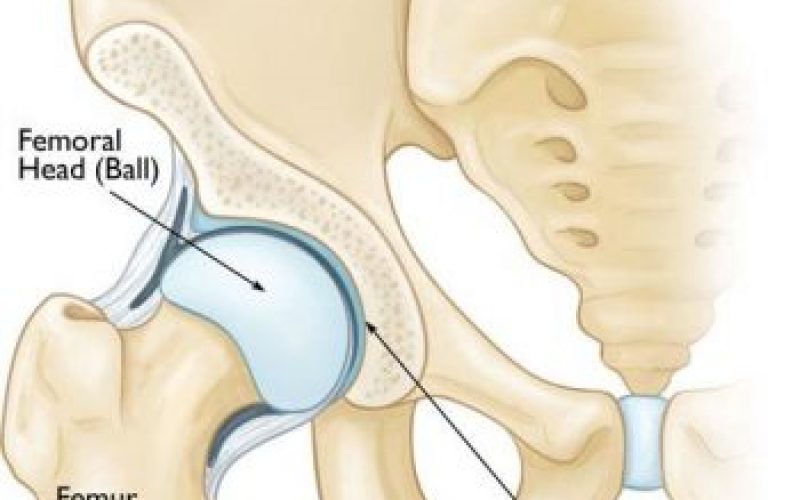Hip problems are common, the cause may be apparent, like an injury that comes on suddenly while gardening, running for the train or playing sports. However, sometimes the reason is not as clear, as symptoms may come on gradually. Hip problems can be one of the kisses of time problems and considered part of the ageing process, although they may affect younger people and children too. These are usually due to a problem with the hip joint itself.
The hip joint is a ‘ball-and-socket’ joint, its strong, stable weight-bearing joint. In a healthy hip, the ball its firmly into the socket, the bones are covered with tough, smooth cartilage, which allows the smooth gliding movement in the socket which is called the acetabulum. Stability is created by a flexible capsule which also produces synovial fluid which aids lubrication and helps the movement. Finally, there are strong ligaments to keep the joint stable.


Hip problems in adults
Osteoarthritis (wear and tear)
This the most common cause of hip problems affecting men and women equally usually from the late 40s onwards. The
risk increases if people had hip problems at birth or abnormal hip development in childhood( see below)
Symptoms
- Pain deep in the front of the groin, and at the side and front of Pain deep at the side and front
- Pain in the buttock sometimes radiating down to the knee
Trochanteric Bursitis
Is particularly common in middle-aged women but can also affect younger people, especially runners and footballers. Unlike hip joint pain, when the pain is usually felt in the groin, greater trochanteric bursitis syndrome results in pain on the outside of the top of the thigh, especially when lying on the affected side.
Symptoms
- Sharp or burning hip pain and tenderness.
- Buttock pain that spreads to outer thigh and knee.
- Pain when pressing on outside of the hip
- Pain with activities such as walking, getting out of a deep chair or sitting cross-legged.
- Pain that disturbs sleep.

Hip fracture
Are most likely to occur in older people who have Osteoporosis, although studies reported that most fractures happen in people who have undiagnosed Osteoporosis but have Osteopenic changes.
Femoroacetabular impingement (FAI)
FAI is usually the result of slight abnormalities in the shape of the head of the femur or the acetabulum, resulting in restricted movement, friction and damage on the bony surfaces and cartilage and to the surrounding soft tissues in the hip joint. FAI is increasingly believed to be a primary cause of hip problems in young adults
Rheumatoid arthritis (RA)
This is an autoimmune disease and the second most common type of arthritis. An autoimmune disease is a condition in which the immune system mistakenly attacks the body. In the early stages, it tends to result in characteristic hand and foot problems and deformity but can also cause hip problems.
Septic Arthritis
Although rare in the hip problem it is a serious joint infection which can affect people of any age. It requires urgent medical treatment.Septic arthritis is also known as infectious arthritis and is usually caused by bacteria, but it can also cause by a virus or fungus.
Symptoms
Usually start quickly with intense pain, joint swelling and may include:
- Chills
- Fatigue and generalised weakness
- Fever
- Inability to move the limb with the infected joint
- Severe pain in the affected joint, especially with movement
- Swelling
- The affected joint is red and warm to touch
Hip problems in infants and children
All babies born in the UK are screened at birth for developmental dysplasia of the hip (DDH), a painless condition that makes the hip joint unstable and prone to dislocation. DDH tends to run in families, it usually affects the left hip and is predominant in:
- Girls
- Firstborn children
- Babies born in the breech position (especially with feet up by the shoulders).
- More likely with women who have Oligohydramnios (low levels of amniotic fluid)
Perthes’ disease also known as Legg-Calve-Perthes,
Is a rare childhood condition it happens when the blood supply to the head of the femur is disrupted temporarily. Without Reduced blood supply results in avascular necrosis (bone cell death) Perthes mainly affects children between 4 -13 years, the first symptom is often a painless limp. It is a complicated process which can last several years.
Slipped capital femoral epiphysis.
This usually affects pre-teens aged 11 years, the main symptoms are pain around the hip or knee and limping.
How to get diagnosed?
X-rays, blood test and scans are sometimes required to make a diagnosis. If you visit an osteopath first, we may need to refer to your GP or a specialist for any additional investigations or treatment.
Treatment
Some problems will settle without any therapy and others might need urgent treatment. It’s that “it depends” answer. Hip problems may cause restriction, discomfort or pain these could be the result of a strain in the joint itself, a tight or overused muscle in or around the hip. Pain can sometimes be referred from the back or related the way you stand to use your hip, knees or ankles. Or to lifestyle; work or hobbies. Visiting an Osteopathic treatment can help several hip conditions, along with, regular exercise that explores alignment and range of motion such as Pilates 2-3 times a week is optimal.
Disclaimer:
Please note: This is for guidance only, it should not be regarded as a substitute for medical advice, diagnosis or treatment given in person by an appropriately trained health professional.







